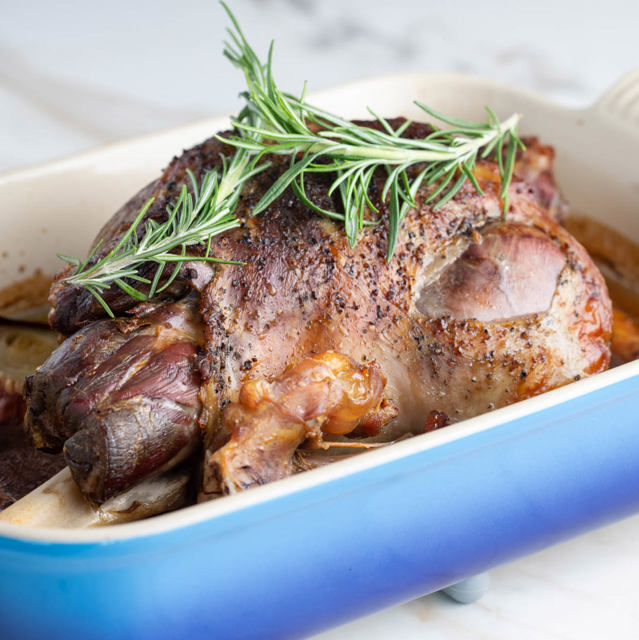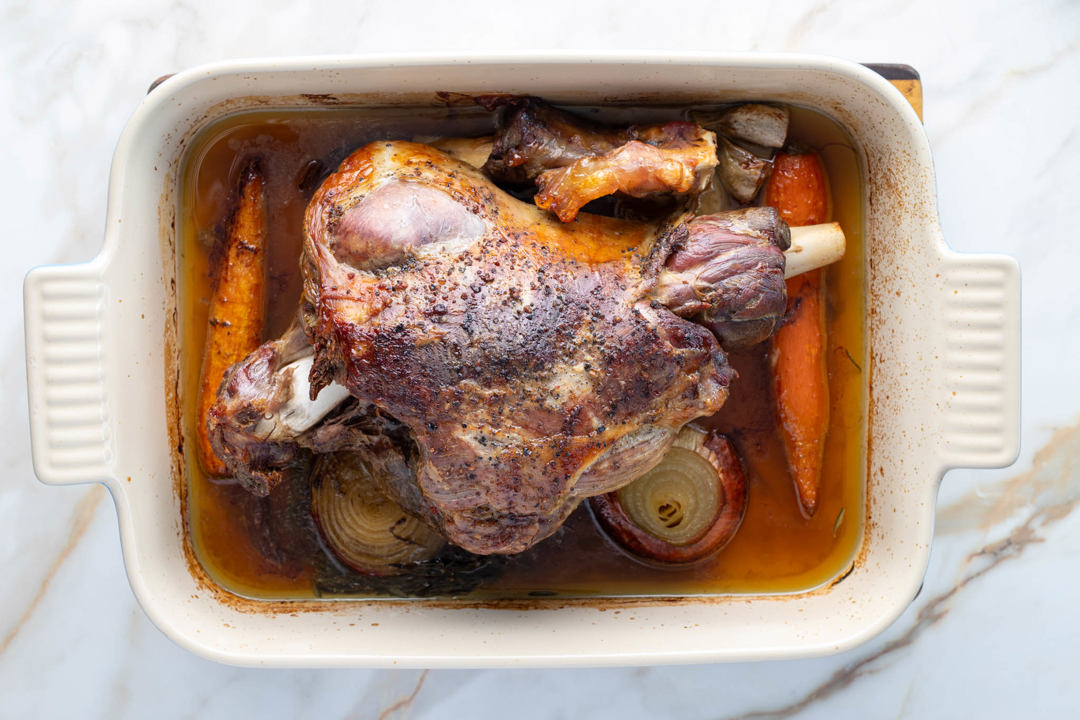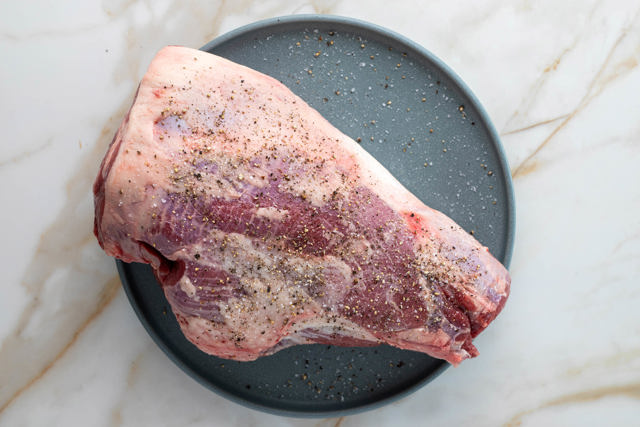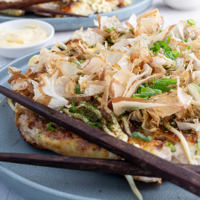We love lamb here in Australia! This slow roasted leg of lamb with garlic rosemary gravy is so very easy to do - put it in the oven a few hours before you want to eat and you don't need to do anything until you start baking your veggies!
Cooked with aromatics perfect for lamb gravy, the lamb gently braises in water and slowly infuses it with flavour for making the best base for your gravy.
This isn't a quick roast - it does take some time - but you end up with meat that is pull-apart tender.
I love the tradition of the Sunday roast. Growing up in Australia, this was something I looked forward to every week where mum would roast beef, pork, lamb or chicken. I'm doing the same tradition with our kids, every Sunday that we're home we do a roast dinner.
Let's talk doneness... I do very much enjoy medium rare lamb, but to pull that off reliably you need a meat thermometer, and you need to watch its internal temperature like a hawk. This slow roasting is much easier to pull off and you won't need a knife to carve it - you can just pull it with tongs or a fork.
Slow Roasted Leg of Lamb ingredients
- Leg of lamb - our hero of the day, we’re after a leg around 2.5kg. Anything around that weight should work, but remember timings will be a little different – see the written recipe. It’s ready when you can pull the meat with tongs or a fork.
- Aromatics for the gravy - we use onion, garlic, rosemary, carrots and celery.
- Salt and pepper to season the lamb
- Flour - regular wheat flour, used to thicken the gravy. You can also use a corn flour slurry to thicken it - see the recipe for details.
- Stock and wine - used to add flavour to the gravy. I always recommend using salt reduced stock because it gives you more control over the salt levels. As for wine, you don't need much and it will all cook off - so it's fine for the kids - but replace the wine with stock if you'd prefer. Use a quality red or white - if you wouldn't drink with it, don't cook with it!
How to make Slow Roasted Leg of Lamb
Halve the onions and garlic horizontally. Remove excess skin but you don't need to peel the skin or anything as you'll strain it off later.
Place the vegetables in the baking pan - arrange the onion, garlic, carrots and celery so that the lamb will be slightly raised and scatter the rosemary sprigs. Add some water to the base of the baking dish so the vegetables are about half submerged.
Season the lamb season both sides of the lamb (1) and then place the lamb on top of the vegetables (2). The outside of the lamb should be moist enough for the seasoning to adhere, but if the salt and pepper isn't sticking use a little oil over the leg.
Wrap tightly in foil and place in the oven at 150C for 2.5 hours.
After 2 hours, carefully remove the foil and rotate the lamb so the side that was previously in the water is facing upwards. Add a little more water if needed, but there should be plenty in there. Replace the foil and bake for a further 2.5 hours.
Check doneness - after 5 hours total cooking time, carefully remove the foil and check the lamb doneness. You should be able to pull it with tongs or a fork. If it's not quite there yet cover again with foil, place back in the oven and check after 30 minutes.
Brown lamb - when the lamb is easily pullable, remove the foil and set aside and place the baking pan back into the oven. Turn the lamb over again and increase temperature to 180C and bake for a further 30-40 minutes until golden brown. If you're having baked vegetables, this is the point you should start cooking them.
Rest - meat cooked like this doesn't need to rest, but resting the meat will allow you to make the gravy and finish cooking your vegetables. Remove the lamb from the oven and place on a large plate or serving platter and cover with foil - you can reuse the foil you cooked it in. It'll stay warm like this for at least an hour.
How to make gravy for the slow roasted lamb leg
The process of baking the lamb with the vegetable and herb base has made a great stock to use as the base of your gravy.
Remove the vegetables - after you've moved your lamb to a serving platter, use a slotted spoon to remove the vegetables, garlic and rosemary from the roasting liquid - they've given all their flavour while the lamb was cooked. Give the base of the baking pan a good scrape to loosen any cooked-on bits.
Pour the roasting liquid into a glass or plastic container using a sieve and allow to settle for 5 minutes. During this time it will naturally separate (see above image), with the fat rising to the surface. Carefully skim off this fat layer into another bowl, leaving you with the stock obtained from cooking the lamb. Depending on how much fat is left in the stock, you may or may not need the separated fat, but it's advisable to retain it as an option for later use.
Heat the baking pan - place the skimmed roasting juices back into the baking pan or skillet and set the temperature to medium - about 6/10. If you baked in stoneware, don't put it on the stove as it will cause it to crack.
Reduce roasting juices and make the roux - as the pan heats, the water in the roasting juices will evaporate. You want to watch it closely when you start getting large bubbles coming off that it doesn't boil dry - you want enough fat left in the pan to be able to make a roux - about 4 tbsp worth of fat. When the liquid is reduced, add 4 tbsp of flour to the pan and use a whisk to incorporate it into the fat in the pan. Add more fat as needed from when you earlier skimmed the stock to be able to make a roux.
Add the wine and stock - add the wine slowly to the roux and whisk it to combine. Let it reduce so the alcohol cooks off and then slowly add the stock to the pan while whisking to incorporate and thicken.
Cook the gravy - bring to a simmer and stir regularly with the whisk to make sure that the gravy isn't catching on the bottom of the pan or forming a skin on the top. Reduce temperature and continue to stir every 30 seconds or so until the gravy is at your desired thickness. If you make the gravy too thick, you can thin it out by adding a little water at a time and whisking to combine.
Season the gravy - season the gravy with salt and pepper to your taste.
Can I cook at a lower temperature?
Absolutely, but cooking time will extend accordingly. Check the meat regularly; it's done when you can easily pull the meat and when inserting a knife gives no resistance - it should feel like butter.
Can I use a lidded casserole rather than foil?
Yes, but you want a lid that seals tight enough to prevent much moisture loss.
My baking pan isn't safe for my stove! How can I make gravy?
When the lamb is resting and you're about to start making the gravy, you can use a wooden spoon to scrape all the flavour off the base of the baking pan. Carefully transfer the liquid to a medium sized skillet or frying pan and proceed following the recipe.
Shoulder or leg for slow cooking?
I do love lamb shoulder, and it offers a better slow cooked result. With that said, shoulders can sometimes be hard to find at supermarkets so the leg makes a good alternative.
Can I use corn flour for the gravy?
If you want to avoid gluten in the gravy, you can use corn flour rather than flour. The method is different though - you can't make a roux with corn flour.
After reducing the roasting juices, add the wine and allow to reduce.
While the wine is reducing, make a slurry of 2 tbsp corn flour to 2 tbsp water in a separate container and mix well.
When you can no longer smell the alcohol and the wine is mostly reduced, add the stock.
Bring the stock to the boil
Stir the slurry and add 1 tbsp of the slurry at a time to the boiling gravy. Stir it into the gravy and watch it thicken. Repeat until the gravy reaches your desired thickness.
Why not to use corn flour?
Using corn flour is easier than making a roux, but there are some negatives.
The traditional look and texture of gravy is achieved from wheat flour.
Wheat flour gravy will reheat much better than corn flour gravy.
With that said if you need to cater to people unable to eat gluten or want less hassle with making the gravy, you can't beat corn flour!
How to reheat and what to do with leftovers.
Roasted meats always reheat best in the oven, and they're even better if you cover them with leftover gravy.
To reheat:
Preheat oven to 160C.
Place the meat along with leftover vegetables on an oven safe plate, add gravy if you have it and then wrap with foil.
Put the plate in the oven for 30 minutes until warmed through.
What to serve with slow roasted lamb leg?
The same things as you would have with a roast meal! Here are some ideas:
- Steamed vegetables, like carrots, peas, corn and cabbage
- Baked vegetables like potato, pumpkin, sweet potato, etc
- Cauliflower and Broccoli - steamed, baked or done in a dish like cauliflower & broccoli cheese

Slow roasted lamb leg
| Prep | Cook | Total |
|---|---|---|
| 10 mins | 300 mins | 310 mins |
- 2.5kg leg of lamb see note 1
- Salt & pepper, for seasoning
- 2 onions halved horizontally
- 2 carrots
- 1 stick of celery
- 1 bulb of garlic halved horizontally
- 4 sprigs of rosemary
- 1 cup of water
- 4 tbsp plain flour
- 500ml stock see note 2
- 250ml wine see note 3
Cook the lamb
- Preheat oven to 150C.
- Season both sides of the lamb with salt and pepper.
- Make the vegetable trivet - in a large roasting pan, arrange the onions, garlic, celery, carrots and rosemary in the base so that the lamb can rest on top of them and not touch the bottom of the pan.
- Place the lamb on top of the vegetables and add 1 cup of water to the base.
- Cover - wrap the roasting pan tightly with aluminium foil.
- Roast in the oven and cook at 150C for 2.5 hours.
- Turn the lamb over - after roasting for 2.5 hours, carefully remove the foil (so it can be reused), turn the leg over so that the side facing the base of the pan is now facing upwards, and reapply the foil. Cook for another 2.5 hours.
- Check doneness - after 5 hours total cooking time, remove the foil and make sure you can pull the lamb with a fork or tongs. If you can't, cover with foil again and return to the oven for another half an hour and then check again.
- Turn the lamb over again and baste. Increase oven temperature to 180C and return to the oven, uncovered for another 30 - 40 minutes or until golden brown. If you're baking vegetables, now's the time to put them in!
- Remove the lamb from the oven and move to a plate. Cover with the aluminium foil to keep it warm while you make the gravy and prepare your vegetables.
To make the gravy
The process of baking the lamb with the vegetable and herb base has made a great stock to use as the base of your gravy.
- Remove the vegetables - after you've moved your lamb to a serving platter, use a slotted spoon to remove the vegetables, garlic and rosemary from the roasting liquid - they've given all their flavour while the lamb was cooked. Give the base of the baking pan a good scrape to loosen any cooked-on bits.
- Pour the roasting liquid into a glass or plastic container using a sieve and allow to settle for 5 minutes. During this time it will naturally separate (see above image), with the fat rising to the surface. Carefully skim off this fat layer into another bowl, leaving you with the stock obtained from cooking the lamb. Depending on how much fat is left in the stock, you may or may not need the separated fat, but it's advisable to retain it as an option for later use.
- Heat the baking pan - place the skimmed roasting juices back into the baking pan or skillet and set the temperature to medium - about 6/10. If you baked in stoneware, don't put it on the stove as it will cause it to crack.
- Reduce roasting juices and make the roux - as the pan heats, the water in the roasting juices will evaporate. You want to watch it closely when you start getting large bubbles coming off that it doesn't boil dry - you want enough fat left in the pan to be able to make a roux - about 4 tbsp worth of fat. When the liquid is reduced, add 4 tbsp of flour to the pan and use a whisk to incorporate it into the fat in the pan. Add more fat as needed from when you earlier skimmed the stock to be able to make a roux.
- Add the wine and stock - add the wine slowly to the roux and whisk it to combine. Let it reduce so the alcohol cooks off and then slowly add the stock to the pan while whisking to incorporate and thicken.
- Cook the gravy - bring to a simmer and stir regularly with the whisk to make sure that the gravy isn't catching on the bottom of the pan or forming a skin on the top. Reduce temperature and continue to stir every 30 seconds or so until the gravy is at your desired thickness. If you make the gravy too thick, you can thin it out by adding a little water at a time and whisking to combine.
- Season the gravy - season the gravy with salt and pepper to your taste.
To make corn flour gravy
If you want to avoid gluten in the gravy, you can use corn flour rather than flour. The method is different though - you can't make a roux with corn flour.
- After reducing the roasting juices, add the wine and allow to reduce.
- While the wine is reducing, make a slurry of 2 tbsp corn flour to 2 tbsp water in a separate container and mix well.
- When you can no longer smell the alcohol and the wine is mostly reduced, add the stock.
- Bring the stock to the boil
- Stir the slurry and add 1 tbsp of the slurry at a time to the boiling gravy. Stir it into the gravy and watch it thicken. Repeat until the gravy reaches your desired thickness.
- Lamb - This recipe was written for a slow roasted leg of lamb, because it can be easier to source than shoulder. The leg benefits from the braise in liquid and the foil cover to help prevent it becoming overly dry. You could use this recipe with a shoulder as well - note that shoulders are a fattier cut and won't serve as many people.
- Stock - we make a simple stock by baking the lamb with the vegetable trivet and water. You need 500ml in total, so if you don't have enough you can use fresh, carton or powdered chicken or beef stock to make it up to 500ml. Always use low salt varieties so you have better control over your seasoning.
- Wine - use whichever wine you like! Just not one that's overly sweet, and of course, only cook with a wine you're happy to drink. If you don't want to use wine in your cooking, sub for extra stock.
- Gravy - recipe includes instructions for making gluten free gravy using corn flour. Note that the texture and look of corn flour gravy is slightly different, and it doesn't reheat well because the corn flour will cause it to clump. corn flour is easier though because you don't need ot make a roux.

























